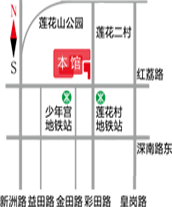
- Jianbi Lingyun's Profound Meaning - Reflections on Shang Lianbi's Art
-
Chen Junyu
Recently, due to my work experience, I had the privilege of being exposed to the art of Mr. Shang Lianbi from Jinling. Through a comprehensive reading of his artistic life, I discovered that Mr. Shang Lianbi, as a senior artist active in the Jiangsu region, has had his artistic career spanning from the New China era to the contemporary era. The twists and turns in his artistic exploration and transformation are not without typical significance. If we focus on and explore his artistic development process in the development and transformation of modern Chinese art, there are many turning points - whether personal factors or era transformation - that are thought-provoking. These are all helpful for us to pursue the significance of artistic exploration and transformation of a typical character in a typical region during the era of change, thus enriching our search for China through case studies. The space for elaborating on the study of modern art social history.
Mr. Shang Lianbi graduated from the Department of Fine Arts at Nanjing Normal University in 1954, making him one of the first generation of students to graduate from art schools in New China. During this period, graduates from art schools were the first generation of "socialist newcomers". From the perspective of art genesis, they carried a fresh socialist cultural value system, with a brand new cultural imagination and artistic identity. This generation of artists mostly had the characteristics of equal emphasis on Chinese and Western art education, solid basic skills, and versatile skills. However, this generation of artists was neither the overseas painters of the 1930s or 1940s nor the traditional painters. How to view and evaluate the artistic value and positive significance generated by the early art education system in New China has not yet been discussed in the art world. A clear statement, however, personally speaking, Shang Lianbi has clearly benefited a lot, As long as we have a brief understanding of Shang Lianbi's early art history, we will find that he was omnipotent in Chinese painting, oil painting, printmaking, and even sculpture in his early years, but ultimately chose to convert to tradition, much like Hu Shi said: "Taking the essence and using the grandeur, from the erudition to the convention, can achieve great success." The experience of Shang Lianbi, who came from a professional background and first engaged in Western painting before choosing Chinese painting, is not an isolated case. The growth of an artist is accompanied by the inevitable phenomenon of the development path of new national art, which is itself fascinating. How to understand and evaluate the unique landscape of modern Chinese painting is not unintentionally profound in its connotation.
The author carefully read Shang Lianbi's early experience of learning painting and was surprised to find that in the early days of the founding of the People's Republic of China, although Chinese and Western art education was parallel, or Chinese painting courses were less than Western painting, the knowledge of Western painting was more rational and instrumental. Although his understanding of Chinese painting was limited, he had a longing for a spiritual background. This is undoubtedly related to his mentor Fu Baoshi, which can be said to have laid the groundwork for his return to Chinese painting creation after the 1980s. When Shang Lianbi walked out of the ivory tower of the academy, it was a time when the country was in a state of great waste waiting to be revitalized. Like his peers, he was full of fighting spirit and picked up his own brush to respond to the call of the times in the fierce construction of New China. Shang Lianbi was famous in the art world of Jiangsu in his early years for his oil paintings and woodcut prints. "From the 1950s to the early 1960s, he almost worked day and night with his knife towards wood. In just four or five years, he published more than 50 woodcut works. These newspapers and magazines include Xinhua Daily, Jiangsu Cultural Revolution Daily, Health Daily, and Tuanjie Daily." "The influence on art was established during a certain period. In 1962, the Jiangsu branch of the Artists' Association was officially established, and he was admitted as one of the first members." (Shang Hui, 2004) Looking at his works during this period, as the philosopher's successor Shang Hui once said, "In terms of the overall woodcut art language and temperament of Shang Lianbi, he emphasized the beauty of masculinity such as simplicity, solemnity, richness, and immaturity, and had a strong personality color." Therefore, regardless of his sketching creation, the composition and techniques of these works were all proficient. Although things have changed, we can still easily read in his works such as "Spring Farming", "Inside and Outside the Great Wall", and "Sorghum Red Over the Mountain Slope" that the author used his unique narrative ability to showcase the high theme of "revolutionary production" in a natural way of life. Of course, this is related to his unique habit as a Chinese painter, which is to generate emotions from things and emotions from fate, especially overflowing with the simple and dignified artistic characteristics in his paintings, Undoubtedly, it is also a continuation of his pursuit of unrestrained and rustic charm in the creation of freehand Chinese painting in the 1980s. However, the author pays more attention to a few rare Chinese paintings created by Shang Lianbi in the later period of the Cultural Revolution: "Exploring the Sea Stone" (1974) and "Yulan Bage" (1973). These two works have novel compositions, unique imagery without losing warmth, and "the opposite is the movement of the Tao" - perhaps this is the artist who suffered hardships during the Cultural Revolution's resistance to the old barriers, thus opening up a conscious desire for a new utopia.
The 1980s was the spring of the Chinese art world. Since 1979, domestic art journals have successively published new voices of the times, approaching the decades long forbidden zone of Chinese art. For example, Wu Guanzhong's "Formal Beauty of Painting" ("Fine Arts" 1979), "About Abstract Beauty" ("Fine Arts" 1980), and "Does Content Determine Form?" ("Fine Arts" 1981) have quickly sparked heated debates on the issue of form. This transitional linguistic conflict of the times is often preceded by the exploration of the aesthetic connotation of Chinese painting, as Wu Guanzhong said: "The relationship between similarity and dissimilarity is actually the relationship between concrete and abstract." This viewpoint can be said to be expressed through modern aesthetic understanding. It is reasonable that Chinese painting underwent a significant transformation in the 1980s due to the freehand spirit of the aesthetic characteristics of the Chinese nation; In 1981, He Rong published "A Further Discussion on" The Peony is Good, The Lilac is Good "(" Fine Arts "), which clearly expressed that" the question of whether to or not to landscape, flowers and birds is no longer a problem. "The voices of the lifting of the ban in these eras are self-evident for us to understand Shang Lianbi's choice of Chinese landscape and flower and bird painting art as a significant development in the 1980s. In fact, Shang Lianbi had already begun his artistic imagination and planning before this new historical trend, which can be observed in his paintings during this period. The painting "Loquat" made in 1981 clearly originated from the late Qing and Shanghai schools, with calm and beautiful strokes and clear colors. The bar and pattern fully displayed the elegant style, while the author sought a solid and overall artistic craftsmanship through the staggered Han stele calligraphy style, indicating that the author attempted to draw inspiration from the modern extension of the Han culture and interest in Jiangnan. According to Shang Hui's recollection, during this period, Shang Lianbi began to "use his greatest skill to enter" and study tradition. He was surrounded by works by Shi Tao, Huang Gongwang, Wu Changshuo, and Ba Dashan Ren, among others. However, his understanding and reflection on tradition were not solely limited to those of the ancients. In the early 1980s, the art world of Miman began with a new wave of rethinking and self construction of tradition. For example, Zhou Shaohua's "Exploration of Thoughts" ("Fine Arts" 1982) focused on rethinking the traditional Chinese aesthetic system and pointed out that "the characteristics of artistic creation and contemporary aesthetic requirements require us to consider the uniqueness of artistic style and the individual creativity of artists." "As a major issue of innovation, sex is a breakthrough." Zhang Anzhi emphasized in "The Transformation of Chinese Painting" (Fine Arts, 1982) that "as the trend of the times changes, art also has to change."; At this time, the discussion and research on Chinese painting brush and ink in the art world became free and enriched, such as Jiang Wenzhan's "A Brief Discussion on the Abstract Beauty of Brush and Ink" ("Fine Arts" 1982) and Liu Jichao's "An Analysis of" Writing Forms with Gods "(" Fine Arts "1982), which can be used as a background to feel the changes in Chinese painting at that time. The transformation of Chinese painting in the Jiangsu region was at the forefront of this literary and artistic transformation. In 1983, the Jiangsu branch of the Artists Association and the Jiangsu Painting Journal jointly held a symposium on the innovation of Chinese painting. This was one of the few large-scale thematic discussions on Chinese painting during that period. The conference discussed many aspects of Chinese painting, but emphasized that the spirit of "freehand brushwork" was the pillar of Chinese painting, and actively explored the evolution and changes of Chinese painting's "writing spirit with form", "writing form with spirit", and "taking form with meaning". These can all serve as a kind of artistic aid for us to interpret the creation of Chinese painting during this period. During this period, Shang Lianbi's works "Spring Comes to the Mountain Plum Blossoms" and "Spring Nocturne" in a panoramic manner were undoubtedly explorations made under the trend of fashion. The re understanding and reconstruction of tradition in the 1980s was a historical trend, and this is a mark of the times. We will not easily judge the superiority or inferiority of these works today. After all, this is a contemporary construction that returns to artistic self-discipline. It is in this construction that Shang Lianbi has walked out of his own pattern of combining freehand flower and bird painting with landscape painting. The author pays special attention to his exploration of freehand flower and bird painting in the modern cultural context, with the aim of re understanding traditional art. In his works, the spirit of modern Chinese painting is organically combined with traditional themes, presenting the author's exploration of the spirit of traditional painting, It further conveys a modern artist's unique insight into the traditional spirit. By carefully reading its brushstrokes, the brushstrokes are loose and dynamic, the ink is thick and heavy, and the interest is floating; It emphasizes more on water techniques, and should incorporate Fu's landscape water techniques into the ingenious ideas of flowers and birds, while seeking the realm of ink and wash integration; And in recent works, they boldly use heavy colors to convey a simple and profound charm, with the intensity of colors increasing the tension of the work. The wit undoubtedly makes its art more modern and compatible.
Mr. Shang Lianbi's art contains some memories of a certain discourse community in the history of modern Chinese art. When reading his works, it is like a revival of the past. When memories are restored to a universal emotional connection, we will feel the retention of a spiritual power bestowed by the era in his works, which should not be ignored by modern society.



